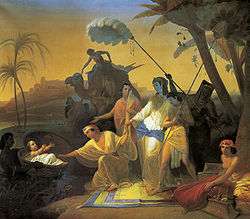Ark of bulrushes
Appearance

The ark of bulrushes daubed with asphalt and pitch, in which the infant Moses was laid (Ex. 2:3), is called in the Hebrew תֵּבָה (tebah, modern teiva), a word similar to the Egyptian teb, meaning "a chest". It is also the same word used for Noah's Ark. The bulrushes (Hebrew: גֹּ֫מֶא gome) were likely to have been papyrus stalks (Cyperus papyrus), daubed with bitumen and pitch (which probably refers to the sticky mud of the Nile).
The ark containing the three-month-old baby, Moses, was placed in reeds by the river bank (presumably the Nile) to protect him from the Egyptian mandate to drown every male Hebrew child,[1] and discovered there by Pharaoh's daughter.
A similar story is told of Sargon of Akkad.[2]
See also
References
- ^ Exod. 1:22
- ^ . New International Encyclopedia. 1905.
